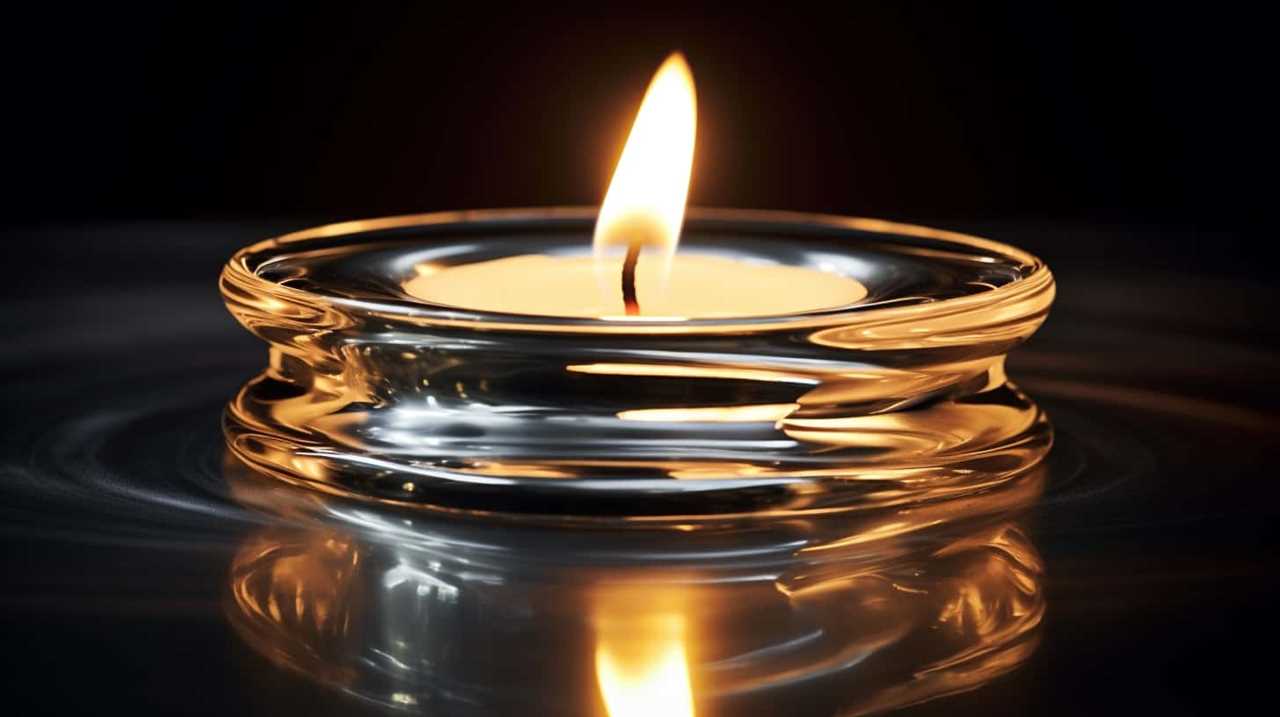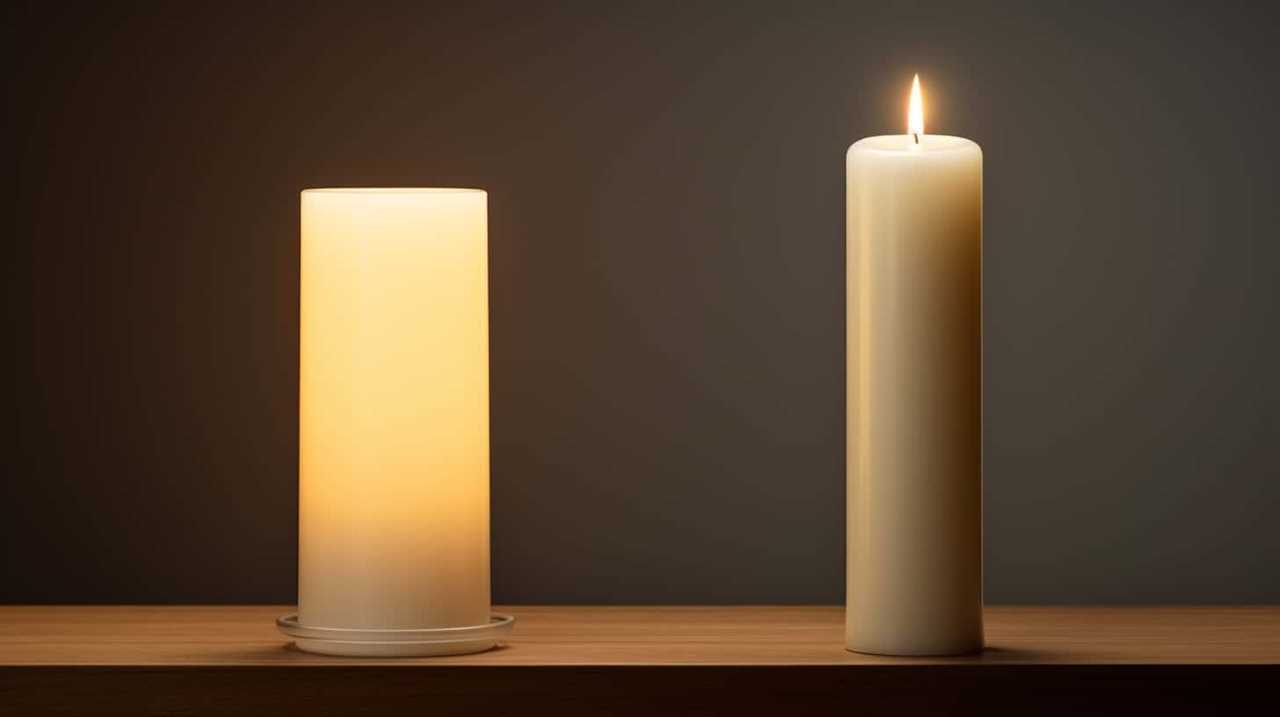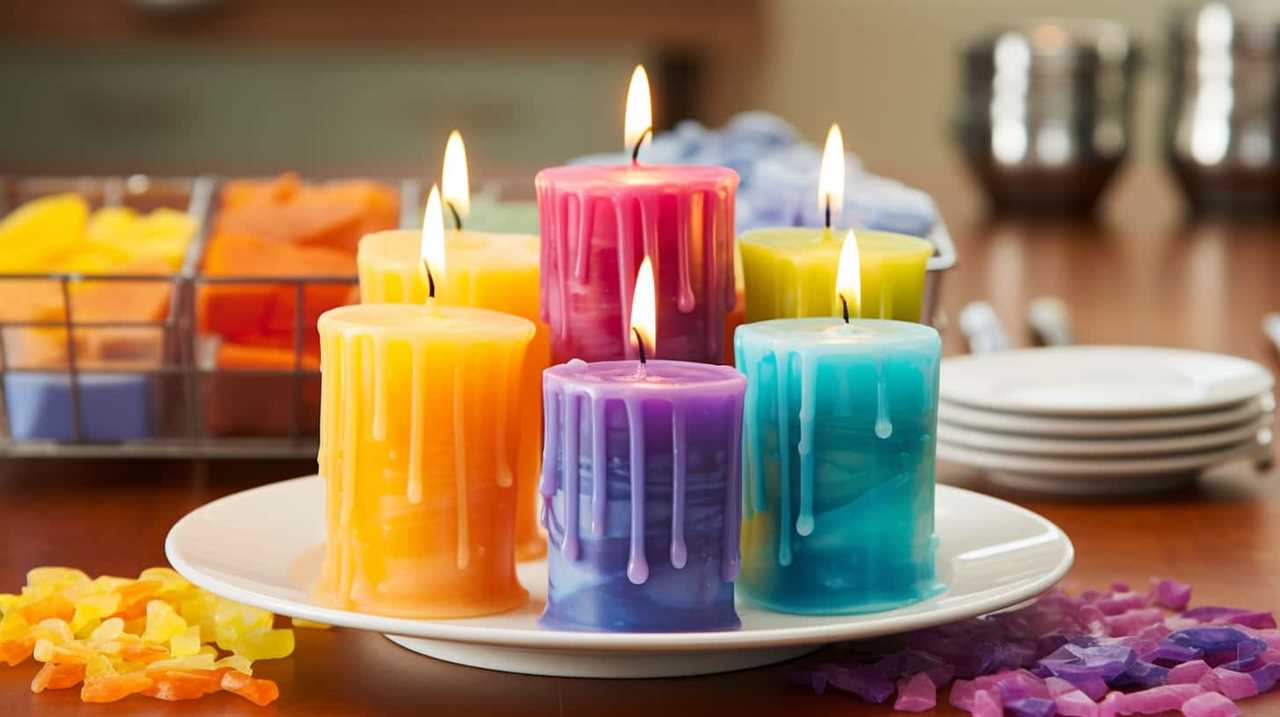When looking for the perfect candle, a common question that comes to mind is, ‘How much scent should be used in a 4 oz candle?’ Find out the perfect balance to create the best aromatic experience!
The answer to this question is like a delicate dance, where the right amount of fragrance can elevate your candle to new heights of aromatic bliss. Mastery in creating scented candles lies in understanding the art of fragrance concentration.
With a keen eye and a touch of calculation, we can achieve the ideal balance of scent that will captivate our senses. In this guide, we will explore the factors to consider when determining the perfect fragrance strength for your 4 oz candle.
So, let’s embark on this fragrant journey and discover the secrets to creating a truly mesmerizing candle experience.

Key Takeaways
- Fragrance oil concentration determines the strength of the scent.
- Adjust the fragrance amount based on the desired intensity and consider the type and size of the container.
- Experiment with fragrance blending techniques and consider the manufacturer’s tips for fragrance concentration.
- Factors such as desired scent intensity, room size, personal preference, and candle size should be considered when choosing fragrance strength.
Why Fragrance Matters for Your Candle
The fragrance in a candle is an essential element that enhances our overall experience. Not only does it create a pleasant atmosphere, but it also has numerous benefits when using essential oils. Essential oils are derived from plants and have natural therapeutic properties that can promote relaxation, improve mood, and even alleviate stress.
When these oils are incorporated into candles, they release their aromatic compounds, creating a beautiful scent that can fill the room. This is where the importance of scent throw comes into play. Scent throw refers to how far the fragrance can travel and how strong it’s when the candle is burning.
A well-made candle with a good scent throw can fill a room with its enticing aroma, providing a delightful sensory experience for anyone in its presence.
Understanding Fragrance Oil Concentration
We need to understand the concentration of fragrance oil for a 4 oz candle. Fragrance oil concentration refers to the amount of fragrance oil used in relation to the total weight of the candle. It determines the strength of the scent and how long it will last when the candle is burned. Different fragrance oils have different properties, so it is important to carefully consider the concentration that will work best for your desired fragrance intensity. Safety is also a crucial factor to consider when working with fragrance oils. It is important to follow the recommended guidelines and use fragrance oils that are specifically designed for candle making. By understanding fragrance oil concentration and adhering to safety precautions, you can create beautifully scented candles that are both safe and enjoyable to use.

| Concentration Level | Fragrance Oil Amount (oz) | Total Candle Weight (oz) |
|---|---|---|
| Low | 0.5 – 1 | 4 |
| Medium | 1 – 2 | 4 |
| High | 2 – 3 | 4 |
| Ultra Strong | 3 – 4 | 4 |
| Super Concentrated | 4 – 5 | 4 |
Calculating the Ideal Fragrance Amount
When it comes to calculating the ideal fragrance amount for a 4 oz candle, there are a few key points to keep in mind.
First, consider the fragrance concentration tips provided by the manufacturer, as this will give you a starting point for determining the amount of fragrance to use.
Next, adjust the fragrance amount based on the desired level of scent intensity.
Fragrance Concentration Tips
To achieve the ideal fragrance amount for a 4 oz candle, we need to carefully calculate the concentration. Here are some fragrance concentration tips to help you achieve the perfect balance:

- Understand fragrance oil application: Different fragrance oils have different strengths, so it’s important to know the recommended usage rate for each oil to avoid overpowering or underwhelming scents.
- Experiment with fragrance blending techniques: Mixing different fragrance oils can create unique and complex scents. Start by blending small amounts and adjust until you find the desired fragrance concentration.
- Consider the type of wax: Different waxes have varying scent throw capabilities. Be mindful of the type of wax you’re using and adjust the fragrance concentration accordingly.
- Take into account the size of the container: The size of the candle container can affect how strong or subtle the fragrance will be. For a 4 oz candle, a higher concentration may be needed compared to a larger candle.
- Test, test, test: Always test your candles to ensure the fragrance concentration is just right. Burn the candle and assess the scent throw to make any necessary adjustments.
By carefully calculating the fragrance concentration and considering these tips, you can create a perfectly scented 4 oz candle.
Now, let’s discuss how to adjust the fragrance for scent in the next section.
Adjusting Fragrance for Scent
To calculate the ideal fragrance amount for a 4 oz candle, we need to adjust the scent by carefully calculating the fragrance concentration. Adjusting the scent intensity involves finding the right balance between the fragrance oil and the candle wax.
The fragrance oil ratio is crucial in determining the strength of the scent. A general rule of thumb is to use about 6-10% fragrance oil for a 4 oz candle. However, this can vary depending on personal preference and the specific fragrance. Some scents may require a higher concentration to achieve the desired intensity, while others may need less.

It’s important to experiment and test different ratios to find the perfect balance. By adjusting the fragrance concentration, you can create a candle that fills the room with a delightful and long-lasting aroma.
When it comes to choosing the right fragrance strength, there are several factors to consider.
Factors to Consider When Choosing Fragrance Strength
One important factor to consider when selecting fragrance strength for a 4 oz candle is the desired scent intensity. To ensure you achieve the perfect balance, here are some factors to consider:
- Candle size: The smaller the candle, the stronger the fragrance should be to effectively scent the room.
- Personal preference: Consider the scent strength that you personally enjoy and find pleasing.
- Room size: Larger rooms may require a stronger fragrance to ensure the scent fills the space adequately.
- Fragrance type: Some scents may naturally be stronger or lighter than others, so take this into account when choosing the fragrance strength.
- Purpose of the candle: Consider the intended purpose of the candle, such as relaxation or aromatherapy, and select a fragrance strength that aligns with that purpose.
Tips for Achieving the Perfect Scent Balance
Here are our tips for achieving the perfect scent balance in your 4 oz candle.

To achieve scent harmony, it’s important to consider the fragrance selection and the amount of fragrance oil used. Here are some helpful tips to guide you:
- Start with a high-quality fragrance oil: Choose a fragrance oil that’s specifically formulated for candle making. This ensures that the scent is strong and long-lasting.
- Follow the recommended usage rate: Each fragrance oil has a recommended usage rate, which indicates the maximum amount of fragrance oil that should be used per pound of wax. Stick to this guideline to avoid overpowering or weak scents.
- Experiment with fragrance combinations: Mixing different fragrance oils can create unique scents. Use a fragrance wheel or consult fragrance notes to find complementary scents that work well together.
- Consider the wax type: Some waxes hold fragrance better than others. Experiment with different types of wax to find the one that allows the scent to shine.
- Test, adjust, and repeat: Always test your candles before selling or gifting them. If the scent is too weak, increase the fragrance oil amount slightly. If it’s too strong, decrease it. Keep adjusting until you achieve the perfect scent balance.
Achieving the perfect scent balance in your 4 oz candle requires careful consideration of fragrance selection and experimenting with different combinations. By following these tips, you’ll be able to create a candle that fills the room with a delightful aroma.
Common Mistakes to Avoid in Fragrance Measurement
We learned from our experiences that avoiding common mistakes in fragrance measurement is crucial for achieving the perfect scent balance in a 4 oz candle.
Here are some common mistakes to avoid when measuring fragrance for your candle:

- Inaccurate measuring techniques: Ensure you use precise measuring tools, such as graduated cylinders or digital scales, to get accurate measurements of fragrance oils.
- Overestimating fragrance potency: Different fragrance oils have varying levels of potency. Avoid the mistake of assuming that all oils need the same amount. Always refer to the recommended usage rates provided by the fragrance supplier.
- Neglecting to account for wax type: Different wax types can affect the scent throw of your candle. Be sure to adjust your fragrance measurements accordingly to achieve the desired scent balance.
- Ignoring fragrance compatibility: Some fragrance oils may not work well together, resulting in a less desirable scent. Always test fragrance combinations before using them in your candles.
- Not allowing for curing time: Fragrance oils may change in scent and potency as the candle cures. Allow your candles to cure for the recommended time to achieve the intended fragrance.
Frequently Asked Questions
What Are Some Common Mistakes to Avoid When Measuring Fragrance for a Candle?
When measuring fragrance for a candle, it is important to avoid common mistakes that can affect the candle fragrance strength. We must be careful not to over or undermeasure, as this can lead to an imbalance in scent.
Are There Any Specific Factors to Consider When Determining the Ideal Fragrance Strength for a Candle?
What factors should we consider when determining the ideal fragrance strength for a candle? How important is fragrance in candles? It is crucial to consider factors such as wax type, desired scent throw, and personal preference to achieve the perfect fragrance balance.
How Does Fragrance Oil Concentration Affect the Scent of a Candle?
Factors influencing fragrance intensity in candles include fragrance oil concentration. Higher concentrations result in stronger scents, while lower concentrations produce milder aromas. Experimenting with different concentrations allows for customization and finding the perfect balance of fragrance for a 4 oz candle.
Can You Provide Some Tips for Achieving the Perfect Balance of Scents in a Candle?
Achieving fragrance balance is key to creating the perfect scented candle. Understanding scent combinations allows us to blend fragrances in a way that enhances each note, resulting in a harmonious and captivating aroma.

Why Is Fragrance Important for Candles?
Fragrance is vital in candle making. It adds depth, ambiance, and evokes emotions. High quality fragrance oils ensure a captivating olfactory experience. They enhance relaxation, create a soothing atmosphere, and leave a lasting impression.
Conclusion
In conclusion, finding the right fragrance concentration for your 4 oz candle is crucial for creating the perfect scent experience.
By understanding the importance of fragrance oil concentration and considering factors such as room size and personal preference, you can achieve the ideal scent balance.
Remember to avoid common mistakes in fragrance measurement and follow our tips to ensure a delightful aroma that evokes emotions and enhances your candle experience.

















